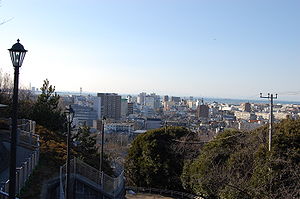Kisarazu
| Kisarazu-shi 木 更 津市 |
||
|---|---|---|
| Geographical location in Japan | ||
|
|
||
| Region : | Kanto | |
| Prefecture : | Chiba | |
| Coordinates : | 35 ° 23 ' N , 139 ° 55' E | |
| Basic data | ||
| Surface: | 138.73 km² | |
| Residents : | 135,765 (October 1, 2019) |
|
| Population density : | 979 inhabitants per km² | |
| Community key : | 12206-8 | |
| Symbols | ||
| Flag / coat of arms: | ||
| Tree : | camellia | |
| Flower : | Rhododendron indicum | |
| town hall | ||
| Address : |
Kisarazu City Hall 1 - 1 Shiomi Kisarazu -shi Chiba 292-8501 |
|
| Website URL: | http://www.city.kisarazu.chiba.jp/ | |
| Location Kisarazus in Chiba Prefecture | ||
Kisarazu ( Japanese 木 更 津市 , -shi ) is a Japanese industrial and port city located in Chiba Prefecture .
In 1976, Kisarazu exceeded the 100,000-inhabitant limit. Kisarazu is therefore a rather small town by Japanese standards. Sometimes the population of Kisarazu is included in the Tokyo metropolitan area .
geography
Kisasazu located on the peninsula Bōsō .
Neighboring cities and communities
climate
| Overview of climate data | |
|---|---|
| Annual average rainfall: | 1560 mm |
| Average temperature January: | 3 ° C |
| Average temperature July: | 26 ° C |
| Average annual temperature: | 16.7 ° C |
The location on Tokyo Bay ensures a balanced marine climate . The temperatures are extremely mild, as Kisarazu is close to the 35th parallel and thus about the same latitude as Cyprus . The from the equatorial region coming warm Kuroshio - power , the east passes by Japan to Alaska, has such a strong heating effect that falls no snow in the winter in Kisarazu.
The direct location by the sea results in little sunshine and an average of at least 10 rainy days per month. The wettest month is September, with an average of almost 180 mm of precipitation on the 20 rainy days. The driest time of the year is December and January, with around 50mm of rainfall per month. The climate is humid all year round .
history
According to legend, Prince Yamatotakeru's boat was hit by strong waves while crossing Tokyo Bay and threatened to capsize. Thereupon the lover of Prince Yamatotakeru sacrificed herself to the sea god in order to appease him, which also succeeded. When the prince reached the shore, he climbed Mount Oda and looked out to sea for his mistress. The fact that the prince lingered for a very long time gave the city its name: the name Kisarazu comes from the Japanese Kimi sarazu , which means something like "The prince didn't go".
Located in the Obitsu Delta , Kisarazu developed into an important trading town in ancient times and in the Middle Ages. In the Tokugawa or Edo period (1603-1867) Kisarazu received the exclusive right to sail between Edo (former name Tokyo) and Boso.
Today's Kisarazu was founded in 1942 through the merger of Kisarazu with the villages of Iwane, Kiyokawa and Namioka; in the years up to 1955 three more villages were integrated into the city. In 1965 ferry traffic to Yokohama and Kawasaki began, after which the port has been classified as an important seaport since 1968. Kisarazu has been an important industrial city since 1992.
Attractions
The Tokyo Bay Aqualine is the city's only attraction and connects Kisarazu with Kawasaki on the opposite side of Tokyo Bay, another important industrial region. The Tokyo Bay Aqualine is a bridge tunnel construction and the fourth longest underwater tunnel in the world.
The Kōzō-ji is the 30th of the "33 temples of the Kantō region" .
traffic
Street:
- Tokyo-Wan-Aqua-Line : to Kawasaki
- Tateyama Highway : to Tateyama
- National Road 16 : to Saitama , Hachioji , Yokohama and Yokosuka
Train:
- JR Uchibo Line : to Chiba or Kamogawa
- JR Kururi Line : to Kimitsu
port
- Kisarazu is a port city
coat of arms
The city coat of arms is based on the symbol 木 ( ki ), which means tree and is the first kanji in the city name. The circle symbolizes the port, the opening of the circle the port entrance.
Commerce and infrastructure
Kisarazu is a transshipment point for all kinds of goods, and therefore the commercial center of the entire region. The industry is not specialized in any particular direction, but mainly consists of classic heavy industry such as steel production , mechanical engineering and petrochemical plants. In 1994 the DNA Research Institute was opened in the Kazusa Technology Park.
Personalities
- Kōji Toriumi (born 1995), football player





